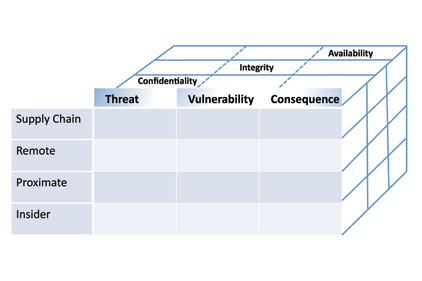
|
Governments and corporations are facing considerable risk to their data, their underlying networks and the reliability of their products because of a confluence of three factors. First, we have adopted vulnerable technologies. Second, we have used these technologies to hold sensitive data and to deliver essential services. Third, we are appealing targets to criminals and spies who have the means, motives and intent to exploit our systems and services.
The Levers of Risk
Interestingly, when we summarize the three above factors, we come up with the classic risk formula, which states that risk is equal to the threat multiplied by the vulnerability multiplied by the consequence (R=TxVxC). These three variables, “threat, vulnerability and consequence,” can be viewed as the levers of risk. By lowering them, individually or in depth, we seek to improve our risk posture. If we can pull any of the three levers to zero, the risk is eliminated entirely.
Avenues of Attack
When it comes to determining a threat actor’s capability, it helps to consider that there are four different attack paths, or vectors of compromise. Bad guys are constantly looking to gain supply chain access, remote access, close access (such as rogue wireless access points) or insider access. Because our attack surface is so great, it remains impossible to defend ourselves 100 percent of the time against all targeted cyber attacks. Still, we have significant opportunities to dramatically improve our cybersecurity.
Building a Cyber Risk Program
Addressing the risk requires prioritization. The need to provide focused effort and enhanced resources to some areas above others is a business-specific exercise that cannot be outsourced. Senior leadership should be involved in determining what data and systems require the greatest attention, and also in determining what levels of remaining or “residual” risk the company is prepared to accept. When prioritizing cybersecurity risk, organizations should consider whether they (or their customers) would suffer low, medium or high consequences due to a loss of the confidentiality, integrity or availability of the data they hold, the information systems they operate and the products they may manufacture that contain embedded software. It is often helpful to explore real-world scenarios which, if they happened in your environment, would have a severe adverse effect on operations, assets or individuals.
Armed with an assessment of their high-priority data and systems, organizations then seek to establish cost effective controls in three areas – administrative, technical and physical – to reduce one or more of the cyber risk quadrants shown in this chart.
Consider what efforts you have in place or could implement that would focus on reducing the threat. For example, as an administrative control, you might conduct employee background checks and establish vendor security requirements. As a technical control, you might deploy cutting-edge capabilities that continuously monitor for malicious endpoint activity and that feed into intelligence sources to identify the intruder, reveal their motives and defeat their methods; and as a physical control, you might have security officers in place and work with law enforcement to apprehend intruders. Consider next what efforts are available to reduce the vulnerabilities within a system. Proper patch management is one example. Application white listing is another. Finally, assume that a threat actor will exploit a vulnerability. Risk mitigation then requires consequence management. Encrypting data may help to protect against the specific harm to confidentiality caused by its theft, but encryption does not protect your data from being deleted altogether and impacting its availability. Appropriate back-up or replacement strategies are required.
Conclusion
Cybersecurity risk management practices are a necessary tool for your organization. Still, there is no “one-size-fits-all” answer. Business needs differ by organization, and they change over time. Like all of security, cyber risk management is a process, and the path is filled with threats, vulnerabilities and consequences; administrative, technical and physical controls; supply chain access, remote access, close access and insider access; and differing harms to confidentiality, integrity and availability. The good news is that, by learning and applying these principles, there are significant opportunities for you to help your organization achieve its security goals.
About the Columnist:
Steven Chabinsky is General Counsel and Chief Risk Officer for cybersecurity technology innovator CrowdStrike, which provides incident response services, cyber intelligence feeds, and a next generation, big data platform for continuous threat detection, attribution, and prevention. He previously served as Deputy Assistant Director of the FBI’s Cyber Division.







